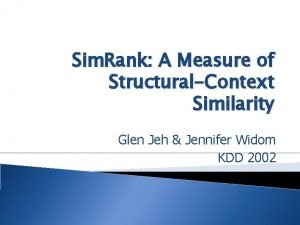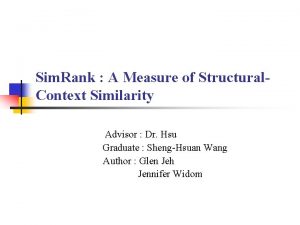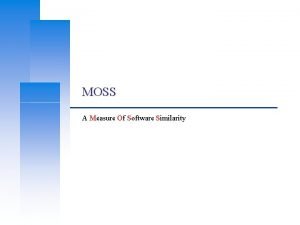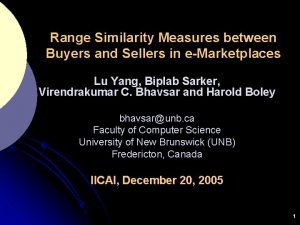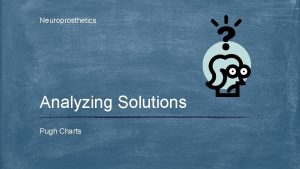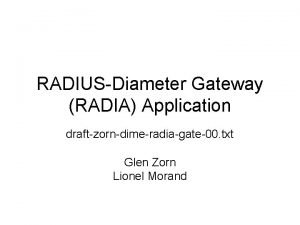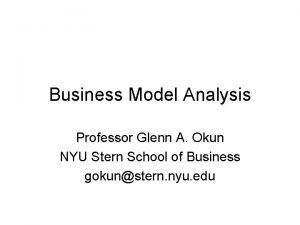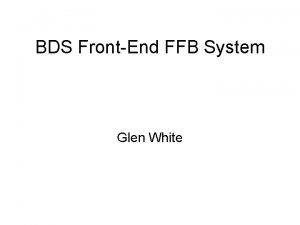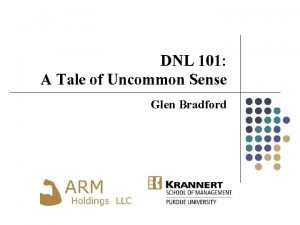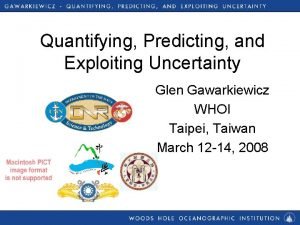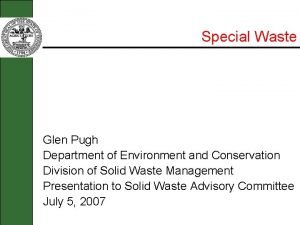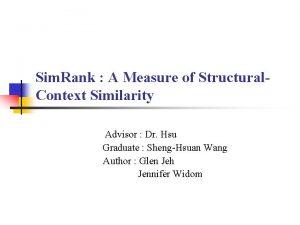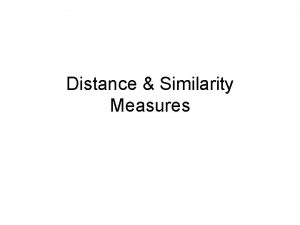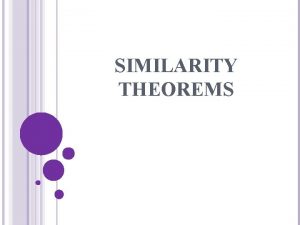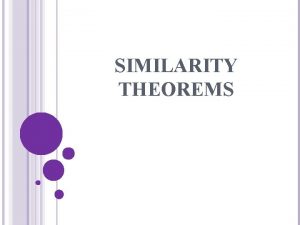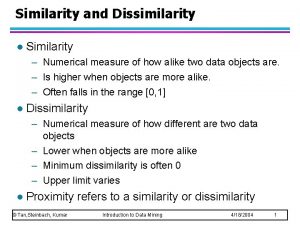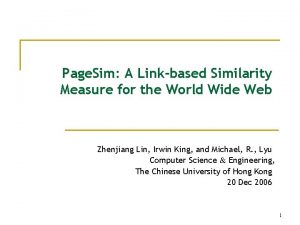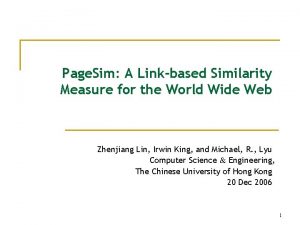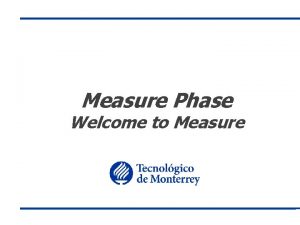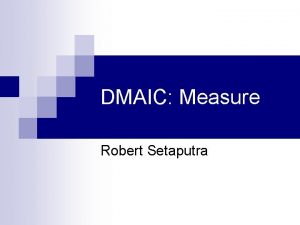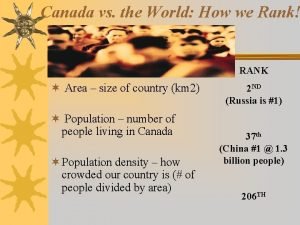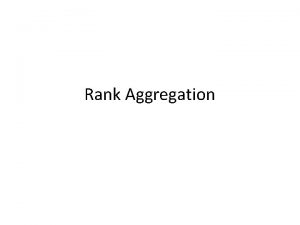Sim Rank A Measure of StructuralContext Similarity Glen



























- Slides: 27

Sim. Rank: A Measure of Structural-Context Similarity Glen Jeh & Jennifer Widom KDD 2002

Motivation Many applications require a measure of “similarity” between objects. § Web search § Shopping Recommendations § Search for “Related Works” among scientific papers But “similarity” may be domain-dependent. Can we define a generic model for similarity?

Common Ground What do all these applications have in common? data set of objects linked by a set of relations. Then, a generic concept of similarity is structural -context similarity. § “Two objects are similar if the relate to similar objects. ” Recall automorphic equivalence: § “Two objects are equivalent if the relate to equivalent objects. ”

Problem Statement Given a Graph G = (V, E), for each pair of vertices a, b ∈ V, compute a similarity (ranking) score s(a, b) based on the concept of structuralcontext similarity.

Basic Graph Model Directed Graph G = (V, E) § V = set of objects § E = set of unweighted edges § Edge (u, v) exists if there is an relation u v § I(v) = set of in-neighbors of vertex v § O(v) = set of out-neighbors of vertex v

Sim. Rank Similarity Recursive Model § “Two objects are similar if they are referenced by similar objects” § That is, a ~ b if c a and d b, and c ~ d § An object is equivalent to itself (score = 1) Example 1. Prof. A ~ Prof. B because both are referenced by Univ. 2. Student. A ~ Student. B because they are referenced by similar nodes {Prof. A, Prof. B}

Basic Sim. Rank Equation s(a, b) = similarity between a and b = average similarity between in-neighbors of a and in-neighbors of b § s(a, b) is in the range [0, 1] § If a=b, then s(a, b) = 1 § If a≠b, § C is a constant, 0 < C < 1 § if I(a) or I(b) = ∅ , then s(a, b) = 0

Decay Factor C X is identical to itself: s(x, x) = 1 a x Since we have x a and x b, should s(a, b) = 1 also? b § If the graph represented all the information about x, a, and b, then s(a, b) would ideally = 1. § But, in reality the graph does not describe everything about them, so we expect s(a, b) < 1. Therefore, the constant C expresses our limited confidence or decay with distance: s(a, b) = C ∙ average similarity of (I(a), I(b))

G 2 Paired-Vertex Perspective Given graph G, define G 2=(V 2, E 2) where § V 2=V x V. Each vertex in V 2 is a pair of vertices in V. § E 2: (a, b) (c, d) in G 2 iff a c and b d in G Since similarity scores are symmetric, (a, b) and (b, a) are merged into a single vertex.

Source and Flow of Similarity Sim. Rank score for a vertex (a, b) in G 2 = similarity between a and b in G. The source of similarity is self-vertices, like (Univ, Univ). Then, similarity propagates along pair-paths in G 2, away from the sources. Note that values decrease away from (Univ, Univ)

Sim. Rank in Bipartite Domains Bipartite: 2 types of objects § Example: Buyers and Items

Bipartite Sim. Rank Equations Two types of similarity: § Two buyers are similar if they buy the similar items § Out-neighbors of buyers are relevant: § Two items are similar if they are bought by similar buyers § In-neighbors of items are relevant: In general, we can use I(. ) and/or O(. ) for any graph

Mini. Max Variant Motivation: Two students A and B take the same courses: {Eng 1, Math 1, Chem 1, Hist 1} § Sim. Rank compares each course of A with each course of B § But intuitively we just want the best matching pairs: s(Eng 1 A, Eng 1 B), s(Math 1 A, Math 1 B) , etc. Solution: Two steps § Max: Pair each neighbor of A with only its most similar neighbor of B. Do the same in the other direction: Min: Final s(A, B) is the smaller of s. A(A, B) and s. B(A, B) [weakest link]

Computing Sim. Rank Rk(a, b) = estimate of Sim. Rank after k iterations. § Initialization: § Iteration: § Rk(a, b) is the similarity that has flowed a distance k away from the sources. Rk values are non-decreasing as k increases. We can prove that Rk(a, b) converges to s(a, b)

Time and Space Complexity Space complexity : O(n 2) to store Rk(a, b) Time complexity : O(kn 2 d 2), d 2 is the average of |I(a)||I(b)| over all vertex pairs (a, b) To improve performance, we can prune G 2: § Idea: vertices that are far apart should have very low similarity. We can approximate it as 0. § Select a radius r. If vertex-pair (a, b) cannot meet in less than r steps, remove it from the graph G 2. § space complexity: O(ndr) § time complexity: O(Kndrd 2), dr = avg. number of neighbors within radius r.

Random Surfer-Pairs Model Sim. Rank s(a, b) measures how soon two random surfers are expected to meet at the same node if they start at nodes a and b and randomly walk the graph backwards Background: Basic Forward Random Walk § Motion is in discrete steps, using edges of the graph. § Each time step, there is an equal probability of moving from your current vertex to one of your out-neighbors. § Given adjacency matrix A, the probability of walking from x to y is pxy = axy/O(x). Random Walk as a Markov Process § Initial location is described by the prob. distribution vector π(0) § Prob. of being at y at time 1:

Random Walk Transition Matrices Given adjacency matrix A: The forward and backward transition matrices:

Paired Backwards Random Walk Probability of walking backwards to x in one step: Two walkers meet at x if they start at a and b, and if one goes x a and the other goes x b, respectively. sx(a, b) = P(meeting at x) = π(a, b) p(x a) p(x b) s(a, b) = P(meeting) = Σx π(a, b) p(x a) p(x b) If they start together, they have met, so s(0)xy = 1 if i = j; 0 otherwise [identity matrix] Then

Experiments: Data Sets Two data sets § Research. Index (www. researchindex. com) a corpus of scientific research papers 688, 898 cross-reference among 278, 628 papers § Student’s transcripts 1030 undergraduate students in the School of Engineering at Stanford University Each transcript lists all course that the student has taken so far (average: 40 courses/student)

Performance Validation Metric Problem: Difficult to know what is the “correct” similarity between items. Solution: Define a rough domain-specific metric σ(p, q): § For scientific papers, we have two versions: σC(p, q) = fraction of q’s citations also cited by p σT(p, q) = fraction of words in q’s title also in p’s title § For university courses: σD(p, q) = 1 if p, q are in the same department, else 0

Computing the Performance Score Run the similarity algorithms: § Sim. Rank (naïve, pruned, minmax) § Co-Citation For each object p and algorithm A, form a set top. A, N(p) of the N objects most similar to p. For each q ∈ top. A, N(p), compute σ(p, q). Return the average σA, N(p) over all q.

Experiment: Scientific Papers Setup § Used bipartite Sim. Rank, only considering inneighbors (validation uses out-neighbors) § N ∈ {5, 10, …, 45, 50} Results § Not very sensitive to decay factors C 1 and C 2 § Pruning the search radius had little effort on rank order of scores.

Results: Scientific Papers

Experiment: Students and Courses Setup § Bipartite domain § N ∈ {5, 10} Results § Min-Max version of Sim. Rank performed the best § Not very sensitive to decay factors C 1 and C 2

Results: Students and Courses Co-citation scores are very poor (=0. 161 for N=5, and =0. 147 for N=10), so are not shown in the graph.

Conclusions Defined a recursive model of structural similarity between objects in a network Mathematically formulated Sim. Rank based on the recursive concept Presented a convergent algorithm to compute Sim. Rank Described a random-walk interpretation of Sim. Rank equations and scores Experimentally validated Sim. Rank over two real data sets

Open Issues and Critique O(n 2) is large; scalability needs to be improved. s(a, b) only includes contributions for paths when a and b are the same distance from some x. What if the distances are offset (total is odd)? As |I(a)| and |I(b)| increase, Sim. Rank decreases, even if I(a) = I(b)! § Addressed partially by Minimax method
 Sim rank
Sim rank Sim rank
Sim rank Measure of software similarity
Measure of software similarity What is the range of similarity measure
What is the range of similarity measure Image similarity measure
Image similarity measure What does a wind vane measure
What does a wind vane measure Gibbons jacobean city comedy download
Gibbons jacobean city comedy download Glen ridge public schools
Glen ridge public schools Pugh charts
Pugh charts Diameter gateway
Diameter gateway Glen okun
Glen okun Glen turner the malt legend
Glen turner the malt legend Yarra glen primary school
Yarra glen primary school Ffb-location
Ffb-location Glen bradford do not lose
Glen bradford do not lose Glen sweetnam
Glen sweetnam Wattle glen landfill
Wattle glen landfill Glenn samaai
Glenn samaai Alopecia glen ellyn
Alopecia glen ellyn Glen gawarkiewicz
Glen gawarkiewicz Glen pugh
Glen pugh Glen otero
Glen otero Fiona glen nice
Fiona glen nice Vulnerability management brisbane
Vulnerability management brisbane Glen clack
Glen clack Glen crawford
Glen crawford Osu
Osu The glen high school
The glen high school
